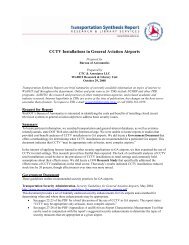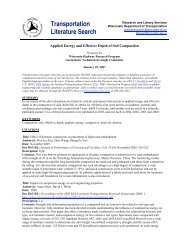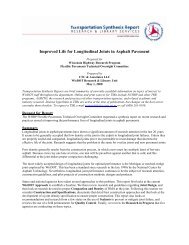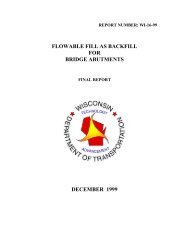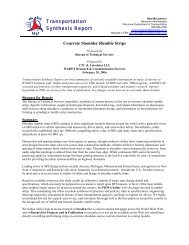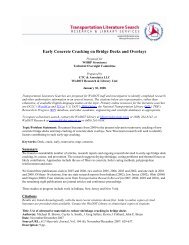DateLaboratory Testing of Portland Cement Concrete Patch Material ...
DateLaboratory Testing of Portland Cement Concrete Patch Material ...
DateLaboratory Testing of Portland Cement Concrete Patch Material ...
You also want an ePaper? Increase the reach of your titles
YUMPU automatically turns print PDFs into web optimized ePapers that Google loves.
addition to these techniques, which all modified the Mn/DOT 3U18 patch material, thisstudy also evaluated a poly-alphamethylstyrene-based concrete curing compound andcompared it to a water-based, wax-based curing compound for its effectiveness inpreventing a loss <strong>of</strong> water from the patch material after it has been placed.3.1 Expansive <strong>Cement</strong>There are a few variations <strong>of</strong> expansive cement available that meet the requirements <strong>of</strong>ASTM C 845 (Standard Specification for Expansive Hydraulic <strong>Cement</strong>); however, onlythe Type K variation is available in the United States (<strong>Portland</strong> <strong>Cement</strong> Association,n.d.). Type K cement is composed <strong>of</strong> <strong>Portland</strong> cement, anhydrous tetracalciumtrialuminosulfate, calcium sulfate, and uncombined calcium oxide (lime) (<strong>Portland</strong><strong>Cement</strong> Association, n.d.). When the cement is mixed with water, the chemical reactionbetween the hydrating aluminum-rich <strong>Portland</strong> cement and the calcium sulfate eventuallyleads to the formation <strong>of</strong> ettringite crystals. Ettringite has a larger volume than itscomponents and causes the concrete to expand, thus compensating for the shrinkage theconcrete will undergo. Eventually, the concrete will achieve a maximum expansion and itwill then begin shrinking at the same rate as it would if regular <strong>Portland</strong> cement wasused, for a net volume change near zero. This expansion and delayed shrinkage reducesor, in some cases, altogether eliminates shrinkage cracking.Many states use Type K cement in concrete bridge deck construction to reduce shrinkagecracking, thereby preventing both premature deck deterioration and reduced durability.WisDOT has used Type K cement on several bridge decks within the last few years and ithas shown good performance overall. However, due to the current high cost <strong>of</strong> the TypeK cement, WisDOT discontinued its use in bridge deck applications.3.2 Expansive AdditiveCommercially available, non-gas producing expansive admixtures are either lime orcalcium sulfoaluminate-based (Standards Association <strong>of</strong> Australia, 1977). Lime-basedexpansive admixtures were not included in this study, due to poor performance results inprevious testing conducted by Mailvaganam, Nunes, and Bhagrath (1993). Calcium4



